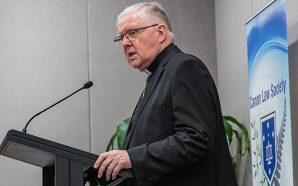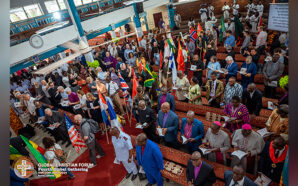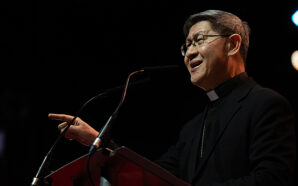This article originally appeared in the March edition of Melbourne Catholic Magazine.
Jesus’ relationships and interactions with women in the gospels are significant and interesting. Equally important are the witness of women and their role in the early Church.
In relation to Jesus’ life, there are encounters with women, such as the woman accused of adultery (John 8) and the Samaritan woman at the well (John 4), which defied conventional legal and moral boundaries and radically challenged their treatment. In a similar way, Jesus’ healing of women with difficult conditions that compromised their social status sought to help women who were being marginalized or outcast, such as the woman with haemorrhage (Matthew 9:20–22, Mark 5:25–34, Luke 8:43–48).
These episodes reflected Jesus’ concern with the spiritual state of women and served as particular revelations of God acting in Jesus.
There are also some significant relationships and friendships that Jesus had with women during his earthly life: with his own mother, of course, and with other women who accompanied him and supported his public ministry, such as ‘Mary, called Magdalene, from whom seven demons had gone out, Joanna, the wife of Herod’s steward Chuza, Susanna, and many others who provided for them out of their resources’ (Luke 8:2–3).
Luke indicates that women provided important practical and moral support for Jesus’ ministry. They did the same for the early and developing Church. Even more importantly, they were disciples in that they learned Jesus’ teaching, and were baptised as equal members of the Christian community.
Significantly, some of the women who followed Jesus were present at the Cross and were the first witnesses to the Resurrection. The gospels mention different names as first witnesses, though Mary Magdalene is named by all four gospels.
It is important for various reasons that the women are singled out. It showed that they remained faithful until Jesus’ crucifixion and death, though they didn’t fully understand what Jesus was doing. Furthermore, women were not legally regarded as legitimate witnesses. However, their witness is integral in the gospels to alerting the male disciples to Jesus’ rising.
Following Jesus’ Resurrection and Ascension, the positive developments regarding women continued. In fact, the early Christian movement brought about important shifts in the way women were treated (many of which have been summarised by the sociologist Rodney Stark).
For example, girls were more likely to survive birth and infancy in Christian families within the Greco-Roman context, as Christians rejected the widespread practice of abortions and infanticide. Young women married later and lived in more stable marriages, as they were not subject to easy divorce laws that favoured men. They also had greater freedom not to marry, which was a major development in the Greco-Roman context.
Moreover, women had significant roles in the Christian community and were subject to the same ethical standards as men, which sought to avoid giving unfair moral license to men. And fundamentally, they had the same dignity and vocation as male members of the community (though official liturgical offices were reserved to men): to receive, live and spread God’s love in Jesus.
Of course, much of the recent attention on women in the early Church has been devoted to Mary Magdalene and her relationship with Jesus. While Mary is a significant figure in the early Church, the recent focus on her is often disproportionate to what we know of her. It often gravitates to the salacious idea of an intimate relationship between Jesus and Mary, though there is no reliable historical evidence for this.
Older suppositions about her as a prostitute are equally unreliable and conflate her with other characters in the gospels. The Gospel of Luke mentions that Mary had seven demons expelled from her, but that is most of what we know about her specifically.
The earliest sources for the Christian movement primarily focus on Mary Magdalene as a follower of Jesus and witness to Jesus’ death and Resurrection. The four canonical gospels, which are the oldest and most reliable sources, name Mary as the first witness to the Resurrection. In John’s Gospel, Mary, who is in a confused and distraught state, encounters the risen Jesus and does not recognise him. While Mary hasn’t fully grasped the significance of the Resurrection, Jesus commissions her to tell the Apostles and disciples about his rising:
‘Stop holding on to me, for I have not yet ascended to the Father. But go to my brothers and tell them, “I am going to my Father and your Father, to my God and your God”’ (Jn 20:17).
Because of this role, Mary became known as ‘the apostle to the apostles’ (‘apostle’ meaning ‘sent one’).
The most recent interest in Mary was the film Mary Magdalene (2018), which purported to tell the story of Mary’s life as she became a social outcast and Jesus’ closest disciple. Mary is juxtaposed to Peter, who supposedly distorts Jesus’ gospel into a violent undertaking and is uncomfortable with a female disciple. Instead, Mary is portrayed as knowing the true essence of the gospel and spreading it among faithful women.
Yet, the problem faced with any reconstruction of Mary Magdalene’s life is the scarcity of information about her. In the earliest sources—the canonical gospels—she is mentioned 13 times. Twelve of the 13 references refer to Mary’s role as witness to Jesus’ death and Resurrection. There is little detail regarding her role in Jesus’ ministry or in the early Church.
The 2018 film relied on the Gnostic Gospel of Mary Magdalene, which is a second century source with dubious historical reliability. This source injects rivalry into the early Church and constructs a secret line of knowledge to a second century sect.
In a similar way, the film draws a false rivalry between men and women in the early Church. While there are some questionable interpretations of the gospel regarding women in the early Church by some of its central figures, the early Christians were largely a united movement intent on living a new kind of communality inspired by Jesus and the Spirit.
It is historically remarkable that this movement survived and grew to the extent it did and, despite its patchy record, largely promoted the place and importance of women as part of its movement.
Dr Joel Hodge is Senior Lecturer in the School of Theology at the Australian Catholic University (Melbourne) and National Course Coordinator for Undergraduate Theology Degrees and Short Courses.
With thanks to Melbourne Catholic Magazine and the Archdiocese of Melbourne, where this article originally appeared.








